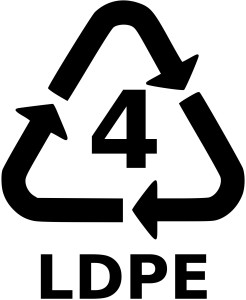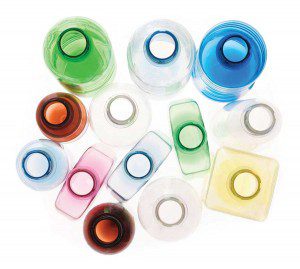By Katrin Geist
Guest Writer for Wake Up World
Ah, the curse of plastics! They surround us on all levels, in all areas of life. They also cause major health and environmental problems. One of my earliest memories is that of Mom tightening and tying up the (plastic) diaper straps around my groin. Not nice when too tight.
Fast forward 40 years: to this day, disposable diapers – while doubtlessly a huge aid to parents everywhere – contribute a mountain of plastic waste that is not easily dealt with. And of course it’s not only diapers. This is but one example of a large problem: introducing exorbitant quantities (245+ million tons of plastic each year — Lithner 2011) of substances to our planet that it has no concept of integrating.
Nature works perfectly in all of her cycles. There is no such thing as waste. Everything is food. Not so in our world. Initiatives like “Cradle to Cradle” and “upcycling” are slowly beginning to change this, however.
[pro_ad_display_adzone id=”110028″]
The above remark does not blame parents who chose to use disposable diapers. Because whether it’s diapers, food containers, house insulation, plastic bottles, shopping bags, pill packets, jacket fill, garden edging, plastic lumber, packaging, carpeting, piping, CDs, car interiors, airplane trays, wheelie bins, coffee cups, or shower curtains – virtually everyone is “guilty” of using plastics on a daily basis.
It would be very difficult to spend a day without using plastic. That would be a fun experiment: how long do you think you could last? What’s your tooth brush made of? Hmmm, perhaps it would be a rather short experiment… and if you happen to have plastic tooth fillings or glasses, well then you’d be excluded from participating altogether.
This article came about as a result of readers responding to a previous article, Truly Healing from Cancer or Preventing it Altogether, wondering what’s what in the plastic world. So here you are.
To help you navigate the plastic jungle, I listed the seven standard types, where they occur, and the more or less known health challenges they may cause. It’s a rough guide to what’s what. While this obviously does not get rid of plastics, at least it allows you to position yourself in a smarter way by cutting them out as much as possible, and choosing those with fewer known harmful effects.
Some are easily avoided: check out these trolley bags, for example. Others are more difficult to not use, but get inventive and cut them out where you can. That alone makes a big difference and contributes to an awareness around the issue. The plastic patch afloat in the Pacific Oceanroughly measures the size of Texas. Do we really want to continue adding to this? Scientists found 10x more plastic particles than plankton in ocean water samples from above patches, referring to this as “plastic soup”. Reducing our use helps a great deal, as a first step, until we only produce polymers that integrate seamlessly with nature or the technosphere (see “The Upcycle” in references). That’s the point where littering isn’t littering anymore, but fertilizing, or a neutral action. This indeed is possible and already happening. Imagine and participate!
The Resin Identification Code: Plastics Number 1-7

Polyethylene Teraphthalate, PETE or PET (polyester)
Used in: detergent & cleaning containers, beverage & water bottles, food containers.
What’s next: PET easily recycles to bottles, fiberfill (sleeping bags, jackets), polyester (carpets, fabrics).
Health effects: PET potentially leaches antimony (Westerhoff et al. 2007). Leakage increases with temperature (think water bottles left in a hot car, for instance). Cheng et al. (2010) found that microwaving these plastics significantly increased leaching also. Andra et al. (2012) showed the co-leaching of brominated compounds and antimony was highest in PET water bottles, compared to other plastics. The EPA maximum contamination level of antimony in drinking water is 6 micrograms per liter, or 6 ppb (parts per billion). When antimony exposure exceeds this limit, even for relatively short periods, nausea, vomiting, or diarrhea may ensue (Westerhoff et al. 2007).
High Density Polyethylene, HDPE
Used in: plastic bags, containers (shampoo, laundry detergent, motor oil), milk and water jugs.
What’s next: clear HDPE easily recycles to new containers; colored HDPE: toys, garden edging, pipes, rope, plastic lumber.
Health effects: HDPE is considered a low hazard plastic. However, as most plastics, it leaches estrogenic chemicals, thus potentially acting as endocrine disruptor (Yang et al. 2011). To what degree these may influence bodily systems remains unclear.

Polyvinyl Chloride
Used in: vinyl pipes, cling wrap, blister packs (medication), clear food packaging, shower curtains, flooring, squeeze bottles, cooking oil & peanut butter jars, home siding, window & door frames, detergents & window cleaner bottles.
What’s next: PVC contains many (toxic) additives which make recycling difficult. Whether it’s recycled or disposed of, potentially harmful substances may be released or created in either scenario.
Health effects: The manufacturing, disposal or destruction of PVC produces harmful substances such as lead, dioxins, vinyl chloride, DEHA, phthalates (eg. DEHP, BBP, DBP), and ethylene dichloride. DEHP, a widely used plastic softener, acts as endocrine disruptor and is known to cause testicular cancer, infertility, and low sperm count in a number of species, including polar bears, deer, and whales (Mercola 2013). It is suspected to have similar effects in humans and Switzerland banned its use in toddler’s toys in 1986 (PVC Information.org 2015). Some phthalates were associated with airway inflammation in children (Just et al. 2012), results echoed by a review study which found evidence for an increased risk of asthma and allergies from phthalates emitted by PVC materials (Jaakola and Knight 2008). Phthalates are also known to possess hepatogenic, teratogenic and carcinogenic properties (Benjamin et al. 2015). A good plastic type to avoid.
 Low Density Polypropylene, LDPE
Low Density Polypropylene, LDPE
Used in: most plastic wraps, some bottles, grocery bags, bread & frozen foods bags, cups, toys.
What’s next: usually not recycled.
Health effects: Considered a low hazard plastic, but, as for HDPE above, it may leach estrogenic chemicals. It is BPA free.
Polypropylene, PP
Used in: outdoor carpet, house wrap, disposable diapers, food containers (deli soups, margarine, syrup, yogurt), baby bottles, straws.
What’s next: Recycling difficult due to different types and grades => consistent quality difficult to attain.
Health effects: Considered a safe plastic. And yet…while PP is marketed as quite heat tolerant, McDonald et al. (2008) found two chemicals leaching from PP-made laboratory equipment. Still, compared to other plastic types, one of the better ones to use.
Polystyrene, PS (styrofoam)
Used in: disposable cutlery, CD cases, food containers, packaging, egg cartons, insulation.
What’s next: Recycling is possible, but usually not financially viable.
Health effects: Polystyrene may leach styrene, a possible neurotoxin and carcinogen (Ahmad and Bajahlan 2007). Animal studies report harmful effects on red-blood cells, the liver, kidney, and stomach (EPA 2000). Styrene can be stored in body fat (Ahmad and Bajahlan 2007) and is usually metabolized to styrene oxide, another possible carcinogen (EPA 2000). The release of styrene is temperature dependent, so using styrofoam cups with hot beverages seems a bad idea. Exposures experienced by factory workers may lead to neurological problems such as slowed reaction time, change in color vision, or balance problems (CDC 2012). Note that styrene levels in manufacturing places far exceed what we’re normally exposed to, however. Nevertheless, “styrene is a contaminant in all PS foam packages” (Ahmad and Bajahlan 2007) and is best left on the shelf: “Considering the toxic characteristic of styrene and leaching in water and other products, PS material should be avoided for food packaging. Especially PS rigid and foam cups should not be used for hot drinks.” (Ahmad and Bajahlan 2007).
 Mixed plastics, OTHER
Mixed plastics, OTHER
Used in: food can liners, bottles (water, baby, sports), lids, electronics, clear plastics, medical storage containers, oven-baking bags, packaging; these plastics are made from a combination of the other six types, or from resins not falling under the other six standard categories.
What’s next: Next to impossible to recycle due to their composite nature (mixed resin).
Health effects: Given the composite nature, tracing effects back to constituents is difficult. However, type 7 plastic often contains BPA, a potent endocrine disruptor (vom Saal and Hughes 2005). Unfortunately, BPA has become ubiquitous over the last 80 years, owing to its use in a multitude of products (e.g. food and beverage packaging, flame retardants, paper coatings, adhesives) (Flint et al. 2012). Best avoided where possible.
Other Acronyms
You might have seen other acronyms such as PBDE, BBP, DBP, or TBBPA. These are chemical additives which endow plastics with certain qualities such as flexibility or toughness. None of them are particularly good for the body, as they – like BPA and others – act as endocrine disruptors, essentially interfering with the body’s hormone system. Plastic additives commonly share a persistence and ubiquitous distribution in the environment, potentially accumulate in the fatty tissues of living organisms, and biomagnify up the food chain (end consumer takes up highest toxic load) (Roth and Wilks 2014). In short, they’re difficult to get rid of.
[pro_ad_display_adzone id=”110030″]
What now?
Unfortunately, above plastics always contain “nasties”, but some more so than others. As a rule of thumb, avoid #3, #6, and #7 as much as you can. Read the label, usually printed at the bottom of containers.
On the bright side, some companies have embraced the huge problem plastic represents, and developed different ways. We now know how to make eatable plastic – in other words, creating a polymer that isn’t only digestible by biology, but also dissolves in water and simply disappears, without the release of harmful toxins. If that’s not revolutionary and worth supporting, I don’t know what is! Many companies already participate along the lines of recycling and reusing, or producing harmless polymers (e.g. soy, corn, starch, or orange peel based bioplastics) that seamlessly integrate with nature. Here are the ones I know of (please add yours in the comments), in no particular order: Cradle to Cradle participants (> 2000 products to choose from), Earthship Biotecture, Patagonia, Plantic Technologies Inc, Nature Works, European Bioplastics (Biokunststoffe), BioPak.
In my mind, these companies contribute to us in a very positive way, contrary to those continuing the old path of polluting the biosphere with substances that not only do not break down, but also contain toxins which accumulate and stick around for decades. What can we do? Reduce our use and becoming conscious of plastic origins and alternatives, thereby adjusting our behavior and consumer patterns. It’s a good beginning. End of the day, money talks. We really vote with our dollars, thus influencing what persists and what becomes obsolete.
Following in the footsteps of Hawaii, there currently is a petition to phase out single use plastic bags in New Zealand. You can support it here if you wish.
Others have gone down the way of converting plastic back to oil. I have not yet researched this, so leaving it at that. A spontaneous thought about this would be to find out how they deal with all the toxic additives. If those can be filtered and rendered harmless somehow, this would be a brilliant approach indeed.
Below link offers an excellent documentary which sums up the impact of plastics very well, and it is clear that we already have alternative technologies. It’s up to us to use and support them, however. Never mind the video quality, just access the valuable information it offers. If you would like to purchase the video, the filmmaker’s website is listed in the references below.
Watch the documentary “Addicted to Plastic” by Ian Connacher.
Easy Ways to Adjust Your Plastic Use
- Leave foods or beverages contained in plastics #3, #6, and #7 on the shelf.
- Avoid heating food in plastic containers. Various chemicals show a temperature related release: the hotter, the more. For the same reason, avoid drinking hot beverages from plastic cups.
- Quit buying plastic bottled water. Use reusable stainless steel bottles instead.
- Wash plastic containers in mild detergents. Harsh detergents help liberate chemicals.
- Avoid using plastic bags. Bring reusable bags when grocery shopping, and your own “to-go” containers when dining out.
- Select safe plastics for food storage. Only use plastic containers #1, #2, #4, and #5 for this purpose. Consider switching to glass storage containers.
Good luck!
Article Sources:
- Addicted to Plastic documentary (2009)
- William McDonough & Michael Braungart. 2013. The Upcycle.
- William McDonough & Michael Braungart. 2002. Cradle to Cradle – Remaking the Way We Make Things.
- Andra et al. (2012). Co-leaching of brominated compounds and antimony from bottled water.
- Ahmad & Bajahlan (2007). Leaching of styrene and other aromatic compounds in drinking water from PS bottles.
- Benjamin et al. (2015). A monograph on the remediation of hazardous phthalates.
- CDC (2012). Styrene info sheet.
- Cheng et al. (2010). Assessment of metal contaminations leaching out from recycling plastic bottles upon treatments.
- EPA (2000). Styrene.
- Flint et al. (2012). Bisphenol A exposure, effects, and policy: A wildlife perspective.
- Jaakola JJK & TL Knight (2008). The Role of Exposure to Phthalates from Polyvinyl Chloride Products in the Development of Asthma and Allergies: A Systematic Review and Meta-analysis.
- Just et al. (2012). Children’s Urinary Phthalate Metabolites and Fractional Exhaled Nitric Oxide in an Urban Cohort.
- Lithner D (2011). Environmental and Health Hazards of Chemicals in Plastic Polymers and Products.
- McDonald et al. (2008). Bioactive Contaminants Leach from Disposable Laboratory Plasticware.
- vom Saal & Hughes (2005). An Extensive New Literature Concerning Low-Dose Effects of Bisphenol A Shows the Need for a New Risk Assessment.
- Westerhoff et al. (2007). Antimony leaching from polyethylene terephthalate (PET) plastic used for bottled drinking water.
- Yang et al. (2011). Most plastic products release estrogenic chemicals: a potential health problem that can be solved.
- The Pacific Garbage Patch. Wikipedia.
- Mercola (2013).
- PVC information.org (2015). PVC: TOXIC WASTE IN DISGUISE (1992).
- Minnesota Department of Health (2013). Phthalates and Drinking Water.
- Companies mentioned above:
- Cradle to Cradle participants (>2000 products to choose from)
- Earthship Biotecture
- Patagonia
- Plantic Technologies Inc
- Nature Works
- European Bioplastics (Biokunststoffe)
- BioPak
Previous articles by Katrin Geist:
- Striking the Balance: Why Optimal Body pH Matters and How to Achieve It
- The FAT Facts: Butter vs Margarine
- The Power of Convictions and How They Shape Our Lives
- 10 Significant Reasons Why Regularly Drinking Green Tea Is An Awesome Healthy Living Habit!
- Cradle to Cradle Design – How a Biochemist and an Architect Are Changing the World
- Truly Healing From Cancer and Preventing It Altogether
- How to Lose Your Mind and Create a New One
- Research Shows Promising Effects Treating Advanced Cancer with Light Frequencies
- Depression & Anxiety: Discover 3 Powerful, Drug-Free Ways that Help Thousands, Naturally
- The Power of Suggestion – Are You Asking the Right Questions?
About the author:
Katrin Geist, BA, MSc, combines her interests in consciousness, personal transformation, and natural healthcare as Reconnective Healing practitioner, speaker, and author. Her monthly “Healthy Living Newsletter” offers original articles like this one on relevant natural healthcare topics.
Katrin has held international Reconnective Healing clinics in several countries and currently works from her New Zealand office in Dunedin. To contact her for personal or remote sessions, send an email to [email protected], or call 0064 (0)21 026 95 806 NZ mobile).
Katrin’s website and blog at HolisticHealthGlobal.co.nz also offer more information on Reconnective Healing and how it helps people regain and retain their wellbeing – naturally and effortlessly: no pills, no needles, no side-effects. Trying this process may well be the best thing you ever did! No more than 3 sessions required to find out what difference this may make for you.
- Website: HolisticHealthGlobal.co.nz
- Facebook: Holistic Health Global Ltd
- Email: [email protected]
- Phone: 0064 (0)21 026 95 806 (NZ mobile)
[pro_ad_display_adzone id=”110027″]









